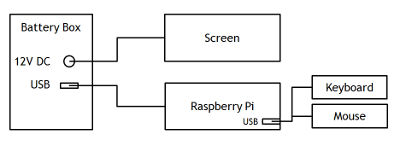EE2 Group Project
Low power computers for schools
in developing rural communities
Background of the Project
 One of the solutions for rural electrification being implemented by e.quinox is the Energy Kiosk. An energy kiosk is a building with solar panels on its roof, which charges battery boxes. It also acts as a shop for the battery box hire scheme, which for a small fee, local people have access to electricity by renting the battery boxes. The battery boxes can power up to two lights and charges mobile phones via USB or AC plug.
One of the solutions for rural electrification being implemented by e.quinox is the Energy Kiosk. An energy kiosk is a building with solar panels on its roof, which charges battery boxes. It also acts as a shop for the battery box hire scheme, which for a small fee, local people have access to electricity by renting the battery boxes. The battery boxes can power up to two lights and charges mobile phones via USB or AC plug. In partnership with Dartmouth Humanitarian Engineering, e.quinox's first hydroelectric kiosk was implemented in the district of Rugote, south-west Rwanda. The USD 40,000 project shall include a pelton turbine with an induction generator, producing a maximum output of 5500W when completed in summer 2013.
In January 2013, e.quinox members returned to Rwanda on an information gathering trip. A meeting with the headmaster of Rugaragara primary school took place during this trip to help us gather more specific requirements which we can feed back into our product. The headmaster specifically requested Office suites to help prepare older students for secondary school and office jobs. They have also requested applications to help them with English and Maths.
Proposed Solution
 Our proposed solution is a Raspberry Pi Model B with a 8" TFT LCD supplied by BBOXX, with a USB mouse and keyboard. The Raspberry Pi will loaded with Raspbian OS, LibreOffice, Google Chrome, VLC media player and two demonstration games which the group developed using Python and PyGame.
Our proposed solution is a Raspberry Pi Model B with a 8" TFT LCD supplied by BBOXX, with a USB mouse and keyboard. The Raspberry Pi will loaded with Raspbian OS, LibreOffice, Google Chrome, VLC media player and two demonstration games which the group developed using Python and PyGame.Click here for more information on the research that was carried out and click here to take a look at our prototype.
Future Development
In terms of hardware, the system needs testing over longer periods of time. At present, the battery-life figures are very much theoretical. The battery boxes are all currently in Rwanda, so it is not possible for the team to do repeated run-down tests to obtain a typical battery-life on a single battery charge. Another main challenge presently is making it robust enough to run in a warm, dusty environment. The screen and other peripherals should stand up to this with care, but the electronics of the Raspberry Pi are very much exposed so a case will need to be created before distribution.In terms of software, the main improvements which could be made to the prototype will need to be established through user trials. The accessibility of the software to a user completely new to computers is an important factor to consider and can only be tested with candidates of the correct level of experience.
We also envisage the content to expand and adapt to the needs of the school. The Raspberry Pi has built-in networking abilities, and so it should be possible to have the games updated over the internet from the UK if a mobile internet module is added to the Raspberry Pi. To be more suitable for the varying ages of the students, further applications could be added to cover a wider range of subjects.
Our ultimate aspiration is for the teachers or students to use the system to learn to write code. We feel that this would actually be the most useful skill that they cannot teach themselves already, and would greatly increase their employability in a country fast approaching the internet age.